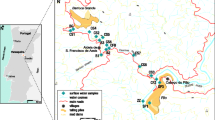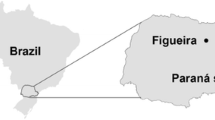Abstract
This study investigates the geochemical characteristics of the acid mine drainage discharged from the abandoned mine adits and tailing piles in the vicinity of the Lousal mine and evaluates the extent of pollution on water and on the stream sediments of the Corona stream. Atmospheric precipitation interacting with sulphide minerals in exposed tailings produces runoff water with pH values as low as 1.9–2.9 and high concentrations of \( {\text{SO}}^{{{\text{2}} - }}_{{\text{4}}}\)(9,249–20,700 mg l−1), Fe (959–4,830 mg l−1) and Al (136–624 mg l−1). The acidic effluents and mixed stream water carry elevated Cu, Pb, Zn, Cd and As concentrations that exceed the water quality standards. However, the severity of contamination generally decreases 4 km downstream of the source due to mixing with fresh waters, which causes the dilution of dissolved toxic metals and neutralization of acidity. Some natural attenuation of the contaminants also occurs due to the general reduced solubility of most trace metals, which may be removed from solution, by either co-precipitation or adsorption to the iron and aluminium precipitates.




Similar content being viewed by others
References
Allison JD, Brown DS, Novo-Gradac KJ (1991) MINTEQA2/PRODEFA2: a geochemical assessment model for environmental systems, version 3.0. User’s Manual, Environmental Research Laboratory, Office of Research and Development, U.S. Environmental Protection Agency, EPA/600/3-91/021, Athens, Georgia, 30605, p 92
ASTM (1984) American Society for Testing Materials, Annual Book of ASTM Standards. Water Environmental Technology, vol 11.01
Barriga FJAS, Carvalho D (1983) Carboniferous volcanogenic sulphide mineralization in south Portugal (Iberian Pyrite Belt), Mem. SGP, no. 29, pp 99–113
Barriga FJAS, Carvalho D, Ribeiro A (1997) Introdution to the Iberian Pyrite Belt. SEG Neves Field
Bigham JM (1994) Mireralogy of ochre deposits formed by sulphide oxidation (Chap. 4). In: Jambor JL, Blowes DW (eds) Environmental geochemistry of sulphide mine-wastes, short course handbook. Mineralogical Society of Canada, vol 22. Waterloo, Ontario, pp 103–132
Bigham JM, Schwertmann U, Traina SJ, Winland RL, Wolf M, (1996) Schwertmannite and the chemicalmodeling of iron in acid surface waters. Geochem Cosmochem Acta 60:2111–2121
Costello C (2003) Acid mine drainage: innovative treatment technologies National Network of Environmental Studies Fellows. US Environmental Protection Agency, Washington, 52 pp
Cravotta CA (1994) Secondary iron-sulfate minerals as source of sulfate and acidity. In: Alpers CM, Blowes DW (eds) Environmental geochemistry of sulfide oxidation. American Chemical Society Symposium Series 550, Washington, pp 345–364
Di Toro DM, Mahoney JD, Scott KJ, Hicks JB, Mays SM, Redmond MS (1990) Toxicity of cadmium in sediments-the role of acid-volatile sulphide. Environ Toxicol Chem 9:1487–1502
Ferreira da Silva E, Cardoso Fonseca E, Matos JX, Patinha C, Reis P, Santos Oliveira JM (2005) The effect of unconfined mine tailings on the geochemistry of soils, sediments and surface waters of the lousal area (Iberian Pyrite Belt, Southern Portugal). Land Degrad Develop 16:213–228
Ficklin WH, Plumlee GS, McHugh JB (1992) Geochemical classification of mine drainages and natural drainages in mineralized areas. In: Proceedings of the 7th international symposium on water–rock interaction, Park City, Utah
Gray NF (1997) Environmental impact and remediation of acid-mine drainage: a management problem. Environ Geol 30:62–71
Jambor JL, Nordstrom DK, Alpers CN (2000) Metal-sulfates salts from sulphide mineral oxidation. In: Alpers CN, Jambor JL, Nordstrom DK (eds) Sulfate minerals—crystallography, geochemistry, and environmental significance. Rev Mineral 40:303–350
Karathanasis AD, Evangelou VP, Thompson YL (1988) Aluminium and iron equilibria in soil solutions and surface waters of acid mine watersheds. J Environ Qual 17:534–543
Kleinmann RLP, Crerar DA, Pacelli RR (1981) Biogeochemistryof acid mine drainage and a method to control acid formation. Min Eng 33:300–304
Langmuir D, Whittemor DO (1971) Variations in the stability of precipitated ferric oxyhydroxides. In: Hem JD (ed) Nonequilibrium systems in natural waters chemistry. Adv Chem Ser 106:209–234
Leistel J, Marcoux E, Thiéblemont D, Quesada C, Sánchez A, Almodóvar G, Pascual E, Sáez R (1998) The volcanic-hosted massive sulphide deposits of Iberian Pyrite Belt. Mineralium Deposita 33:2–30
Letterman RD, Mitsch WJ (1978) Impact of mine drainage on a mountain in Pensylvania. Environ Pollut 17:53–73
Levy DB, Custis KH, Casey WH, Rock PA (1997) The aqueous geochemistry of the abandoned Spenceville Copper Pit, Nevada Country, California. J Environ Qual 26:233–243
MacDonald DD, Ingersoll CG, Berger TA (2000) Development and evaluation of consensus-based sediment quality guidelines for freshwater ecosystems. Arch Environ Contam Toxicol 39:20–31
Matzke, K (1971) Mina do Lousal. Principais Jazigos Minerais do Sul de Portugal. Liv-Guia 4:25–32
Monterroso C, Alvarez E, Macías F (1994) Speciation and solubility controls of Al and Fe in minesoil solutions. Sci Total Environ 158:31–43
Nordstrom DK (1982) Aqueous pyrite oxidation and the consequent formation of secondary iron minerals. In: Kittrick JA, Fanning DS, Hossner LR (eds) Acid sulphate weathering. Proceedings of a symposium sponsored by Divisions S-9, S-2; S-5, and S-6 of the Soil Science Society of America in Fort Colins, 5–10 August 1979 (SSSA special publ. no. 10) Colorado, pp 37–56
Oliveira JT et al (1984) Carta Geológica de Portugal 1/200000, Notícia Explicativa Fl. 7 SGP
Oliveira VMJ, Matos JX, Rosa C (2001) The NNW sector of the Iberian Pyrite Belt—new exploration perspectives for the next decade. Geode Workshop —massive sulphide deposits in the Iberian Pyrite Belt: new advances and comparison with equivalent systems, Aracena, Spain, pp 34–37
Parkhurst DL (1995) Users guide to PHREEQC: a computer model for speciation, reaction-path, advective transport and inverse geochemical calculations, U.S. Geological Survey, Water-Resources Investigations, Report 95–4227
Reis AP, Ferreira da Silva E, Sousa AJ, Matos J, Patinha C, Abenta J, Cardoso Fonseca E (2005) Combining GIS and stochastic simulation to estimate spatial patterns of variation for lead at the lousal mine, Portugal. Land Degrad Develop 16:229–242
Schermerhorn L, Zbyzewski G, Ferreira V (1987) Carta Geol. Portugal 1/50000 42D Aljustrel, SGP, p 55
Schum M, Lavkulich L (1999) Speciation and solubility relationship of Al, Cu, and Fe in solutions associated with sulphuric acid leached mine waste rock. In: Environmental geology, vol 38, no. 1. Springer, Berlin Heidelberg New York, pp 59–68
Silva F (1968) As Minas do Lousal. Bol. Minas, Dir. Geral de Minas e SGP, 5 (3), pp 161–181
Strauss G (1970) Sobre la geologia de la provincia piritífera del SW de la Península Ibérica y de sus yacimientos, en especial sobre la mina de pirita de Lousal (Portugal). Mem. ITGE T. 77, pp 266
Stumm W, Morgan JJ (1981) Aquatic chemistry: an introduction emphasizing chemical equilibria in natural waters. New York, Wiley
Sullivan PJ, Yelton JL, Reddy KJ (1988) Solubility relationships of aluminium and iron minerals associated with acid mine drainage. Environ Geol Water Sci 11:283–287
Tornos F, Barriga F, Marcoux E, Pascual E, Pons JM, Relvas J, Velasco F (2000) The Iberian Pyrite Belt. Database on global VMS districts. In: Large R, Blundell D (eds) CODES SRC, Tasmania, pp 19–52
Acknowledgments
This study was made possible with the financial support provided by IAPMEI (Instituto de Apoio ás Pequenas e Médias Empresas e ao Investimento – Ministério da Economia). Particular acknowledgments are addressed to Instituto Geológico e Mineiro (presently INETI Inovação) for authorizing the use and the publishing of the geochemical and hydrochemical data from the Project “Estudo do Controle Ambiental nas áreas mineiras abandonadas de Lousal e Caveira). The anonymous reviewers are thanked for their comments and suggestions on the manuscript, which helped to improve this paper.
Author information
Authors and Affiliations
Corresponding author
Rights and permissions
About this article
Cite this article
da Silva, E.F., Patinha, C., Reis, P. et al. Interaction of acid mine drainage with waters and sediments at the Corona stream, Lousal mine (Iberian Pyrite Belt, Southern Portugal). Environ Geol 50, 1001–1013 (2006). https://doi.org/10.1007/s00254-006-0273-6
Received:
Accepted:
Published:
Issue Date:
DOI: https://doi.org/10.1007/s00254-006-0273-6




